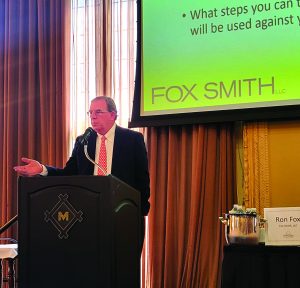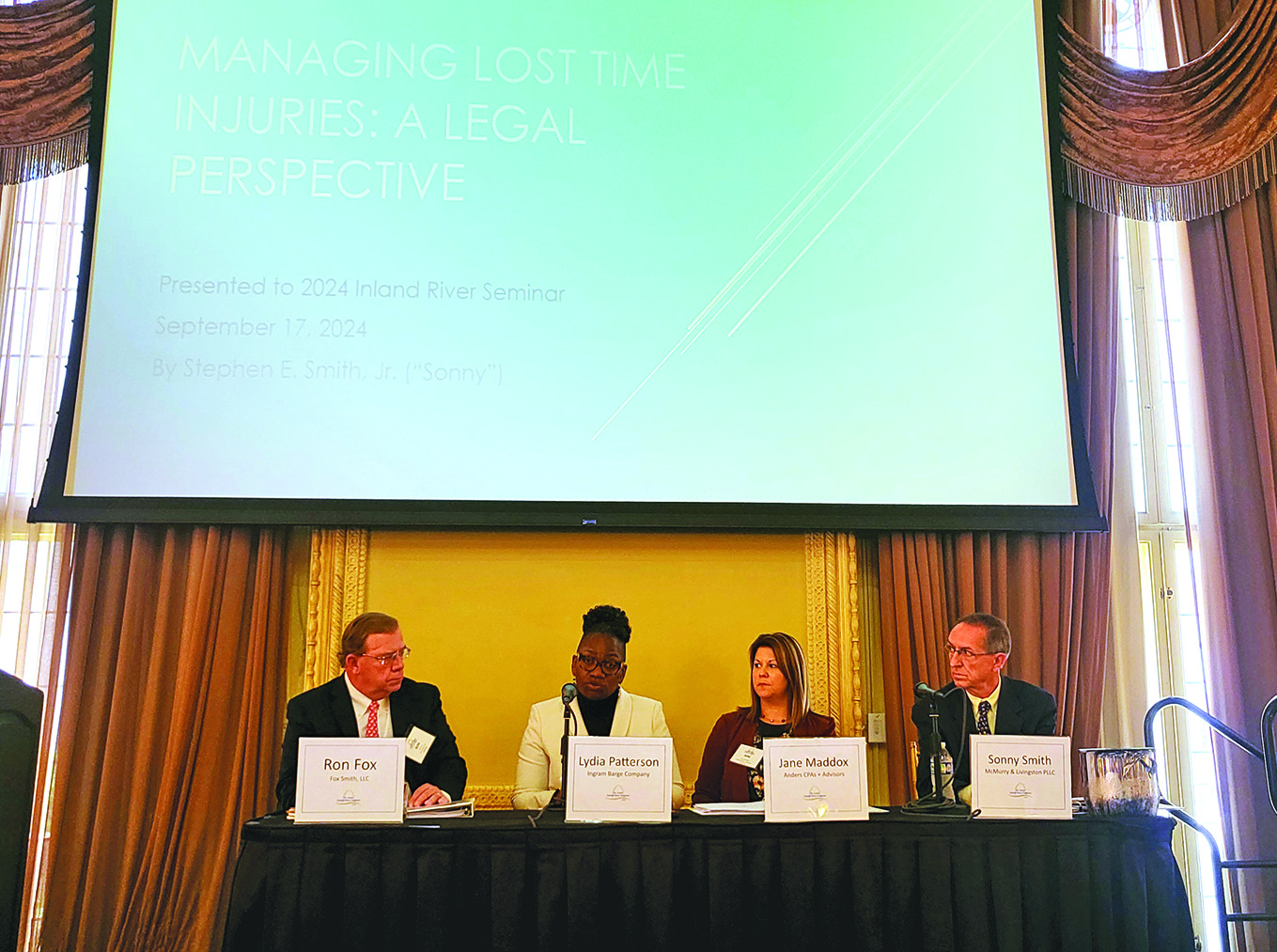The St. Louis Inland River Seminar continued its steady growth with its third event September 16-17 at the Missouri Athletic Club (MAC) in downtown St. Louis. The seminar is hosted by Fox Smith LLC and supported by a range of river-related businesses. The event is nonprofit, and after covering the cost of the seminar, all revenues are donated to the Seamen’s Church Institute. Speakers and panelists speak pro bono.
Veteran maritime attorney Ron Fox, who has served on panels at other maritime law seminars and is a well-known industry leader,

moderated and introduced the speakers and panels.
To accommodate the growth in attendance, the event moved into a larger ballroom at the MAC, an older room with elaborate carved ceilings and excellent acoustics. Attendees heard updates on the U.S. Coast Guard’s new sexual assault and harassment (SASH) reporting requirements, as well as discussions on lost time injuries, the complications of loss coverage of freight cargoes and a “lighting round” that covered many frequent issues in commercial towing and barging. Topics are chosen in response to attendee surveys from past seminars.
Capital Construction Fund
The first panel, presented by maritime law veteran Jim Kearns, covered details of the Capital Construction Fund (CCF), a topic Kearns has spoken about at the Inland Marine Expo. While the CCF has existed for decades–for blue-water vessels since the Merchant Marine Act of 1936–the program was expanded to include inland vessel owners in 2022. It was originally designed to create tax incentives for shipowners to build more vessels as war loomed.
Program participants can create special tax-exempt accounts if they use the money in it for authorized purposes–mainly building vessels, rebuilding a qualified vessel or paying principal on debt incurred in connection with construction of a qualified vessel. Kearns compared these accounts roughly to a health savings account. The money in these accounts is from the vessel owner or operator and is tax-exempt. No federal money is involved.
Upgrades that extend a vessel’s useful life may qualify. The CCF program is administered by the Maritime Administration rather than the Internal Revenue Service, even though it is a tax exemption program, because its purpose is to encourage more vessel construction. The other policy goal is to create more work for shipyards.
Under the program, vessel owners or operators can channel income from certain vessels into a tax-exempt account. Scheduled deposits should have some relation to a construction schedule, Kearns said. Withdrawals for unauthorized purposes may be subject to deferred taxes.
The CCF doesn’t fully define what qualifies as a “vessel,” Kearns said, so the program’s expansion has opened up questions. There are some limitations as to how program users can spend their money. For example, they can’t buy used equipment with it.
n late July, Reps. Mike Ezell (R-Miss.) and Troy Clark (D-La.) proposed a further expansion of the CCF program to include marine terminal operators, Kearns said. That bill appears to have been deferred for action to the next Congress.

Managing Lost Time Injuries
Fox opened the lost-time incidents panel by noting that about 95 percent of all civil litigation is settled before trial. The goal of any attorney representing a company is to keep injuries or lost-time incidents from becoming a lawsuit, he said.
Panelists included Lydia Patterson, director of claims for Ingram Barge Company, CPA Jane Maddox and maritime attorney Sonny Smith from Paducah, Ky. Patterson began by stating that Ingram is a family-oriented company, and its policy is to practice transparency at every level. Making contact with the injured party right away is important, preferably while he or she is still on the vessel. If the injury is minor, creating opportunities for the mariner to continue working on light duty is important.
Patterson said it’s also important to thoroughly investigate all incidents, including the past medical history of the worker. Fox reiterated the point that seemingly minor wrist or knee injuries should not be dismissed, he said, since they can have repercussions later. If it’s appropriate, the company may want to offer the employee financial support beyond maintenance and cure payments, which are due to injured Jones Act mariners regardless of fault.
Fox raised an important point about the investigation. If it is determined that the employee’s actions contributed in any way to the incident or his or her injuries–a safety protocol violation, for instance–the company will want to get that on the record and in the employee’s file. This doesn’t mean the company has to be confrontational or take any punitive action at a time when the employee may already be suffering. It’s purely a protective measure if the case goes to trial and if the plaintiff attorney is claiming negligence on the company’s part.
Sometimes these cases go to mediation, and Patterson said whenever she has a mediation meeting, she sets a defined departure time in principle to avoid drawn-out negotiations.
Smith spoke about maintenance and cure payments, which derive from the Osceola decision of 1903 when mariners were declared “wards of the court” due special protections. The maintenance payments are supposed to cover “reasonable” food and lodging expenses during recovery, while cure covers medical costs to the point of maximum medical improvement. The mariner has the burden of proof, but the law resolves all doubts in his or her favor. Smith noted the company has both the duty and the right to investigate incidents. The mariner has the choice of a doctor, but the total cost can’t be more than the doctor the company provides.
There are certain strictly defined conditions under which a company may refuse maintenance and cure payments, including misrepresentation of prior injuries, refusal of medical treatment, misconduct or the employee not qualifying as a Jones Act seaman.
Fox recommends that his client companies have all employees fill out a simple form upon boarding a vessel, or separating from it, asking if they have been injured, seen a doctor or changed medications during their service. These can be important evidence if contradicted by later claims.
SASH Reporting
The panel on sexual assault and harassment (SASH) reporting was an event highlight. These reporting requirements have caused strong industry reaction and stimulated lively discussion at the Greater New Orleans Barge Fleeting Association seminar earlier this year, which featured a panel of top Coast Guard enforcement officials. SASH reporting requirements were part of the Safer Seas Act, attached to the National Defense Authorization Act of 2022.
According to panelist Michelle Bogosh, senior counsel at Archer Daniels Midland, the Safer Seas Act took even the Coast Guard by surprise. The Safer Seas Act was passed after an outcry in response to the Midshipman X incident in which a female cadet of one of the maritime academies was assaulted aboard a blue-water vessel. Among provisions in the Safer Seas Act is a requirement for the Coast Guard to revoke or suspend a license, certificate of registry or merchant mariner’s document for any individual who has been convicted of sexual assault within the previous 10 years and to revoke or suspend such credentials for any individual who has been convicted of sexual harassment within the previous five years.
Maggie Gentzen, a Fox Smith partner, made clear there is no chance of the Safer Seas Act being repealed as some maritime interests have called for. There are also state laws that have requirements for reporting incidents, Gentzen said, including the Illinois Human Rights Act and Missouri Human Rights Act. Twenty-one states also have VESSA laws (Victims Economic Security and Safety Act) that may require victims of sexual assault or harassment to be removed from any situation where they might be under threat.
SASH laws generally recognize two types of sexual harassment: quid pro quo (solicitations of sexual favors for rewards) and the creation of a hostile environment by inappropriate comments, jokes, physical touching, texts, etc. There is no red line marking when a conversation creates a hostile environment, but in practical terms, it depends on what a “reasonable person” in a jury might think. Not all states currently have mandatory SASH training, Gentzen said, but it’s a good idea for companies to have it since the training will eventually be mandatory everywhere. Many inland companies already do. Some states require “bystander” training as well, and there may be a requirement of anyone who knows of an incident to report it.
Congress may eventually clarify some ambiguous provisions, such as defining what conduct constitutes “harassment” and who (besides the owner, operator and master) qualifies as a “responsible entity of the vessel” who must report incidents or be subject to a $50,000 fine for failing to do so. Until that issue is resolved, Gentzen’s advice is, “Don’t get cute. Report an incident if you have any connection with the vessel at all.” Reports to the Coast Guard must be made “immediately,” a term also left undefined, but Gentzen said within 24 hours is a safe assumption.
In answer to a question, Bogosh said the Coast Guard’s reporting rules do not allow anonymous tips. However, a company’s own policies can do so. She also said the Coast Guard is still working out its own procedures for investigating an incident. Five years ago, she said, the Coast Guard had four incidents in its docket. As of September, the agency is managing 408 active investigations. Apart from that, the Coast Guard cannot keep companies informed of an investigation’s progress.
After Action Summary
Among the Safer Seas Act’s provisions is a requirement for employers to submit an After Action Summary (AAS) within 10 days of an incident, detailing what corrective actions have been taken. Ten days is usually not long enough to complete an investigation, and Bogosh noted that the AAS need not be complete or even come to any conclusion. Rather, the AAS is a notification to the Coast Guard that the employer is responding properly. The summary should list who has been interviewed or who the company has attempted to contact.
For employers living under this reporting regime, the practical implications are clear, Bogosh said. Companies should post notices aboard all vessels that include contact numbers, conduct at least annual SASH training, review safety policies and insert conditional clauses into job offer letters.
Lightning Round
Next was a “lightning round” discussion of recurring and popular topics, with panelists including Fox and two Fox Smith partners, Stas Levchinsky and Ted Lucas. Lucas began a discussion of root cause analyses (RCAs) by noting that they are probably the least popular document for Jones Act defendants. “Has the widespread adoption of RCAs actually improved safety?” he asked rhetorically.
The discussion centered on ways for defendants to protect RCAs, if they exist, from being discoverable in a court proceeding. That’s important because RCAs provide a “road map” for plaintiff attorneys. Even if the document itself proves inadmissible, the topics it addresses can still be introduced one by one by the plaintiff attorneys.
If prepared by in-house personnel with no input from attorneys, RCAs are usually discoverable. However, if a company involved an attorney in its preparation, RCAs may be protected from discovery under attorney-client privilege and “work product” privilege. That privilege can even cover documents prepared by others under an attorney’s direction.
Another question, on which courts have divided, is whether or not corrective actions recommended by an RCA after an injury or incident are admissible as evidence.
The next panel topic was Jones Act negligence and per se liability. Levchinsky pointed out that, in the past, it was easier for companies to demonstrate compliance with all relevant Coast Guard regulations. But in the wake of this summer’s Loper Bright Supreme Court decision, which removed the doctrine of Chevron deference stating that federal agencies have the final say on what their regulations mean, plaintiff attorneys have more scope to question the wording of those regulations–and challenge whether a company has complied with them. Levchinsky noted that reference to common or accepted practices or “what everyone does” may not be enough in all cases. The 1903 Osceola decision—the same one that began the formal obligation of maintenance and cure for injured mariners— was also the basis for the longstanding prohibition against a seaman suing anyone other than his or her employer under the Jones Act. That changed, however, in 2006 when the Jones Act was amended. Now, in the view of some courts, a Jones Act seaman may sue, individually, certain co-workers. This means that an injured mariner could sue the captain or other officers individually as well as the company under the Jones Act.
However, Fox said, he advises companies against buying separate liability insurance for officers because more insurance coverage creates a fatter target for plaintiff attorneys.
The panel also discussed when to order an independent medical exam and when venue agreements are appropriate.
Liability For Cargo Loss
The last panel discussed a rare topic: the freight contracts governing who is liable in cases of cargo loss. Fox used a hypothetical example of a cargo of steel coils traveling from Japan to the Gulf and upriver to Chicago. Who is responsible for the cargo in case of damage or loss and at what points in the cargo transit? Is it the owner, carrier, shipper, freight forwarder, towing company or stevedore?
The panel distinguished between the different rules governing common carriers and private carriers. Private carriers, including virtually all brown-water towing companies, generally have more freedom to allocate risk.
Contracts of affreightment often carry a clause limiting responsibility for cargo damage to a certain small dollar amount, often $500. This is called “package limitation.” The Carriage of Goods by Sea Act limits a carrier’s liability, but the act is not widely accepted for private carriers. Carriers can “write out” most liability if the other contract parties agree. The panel discussed several recent court cases that address some of the cargo protections in freight contract clauses.




